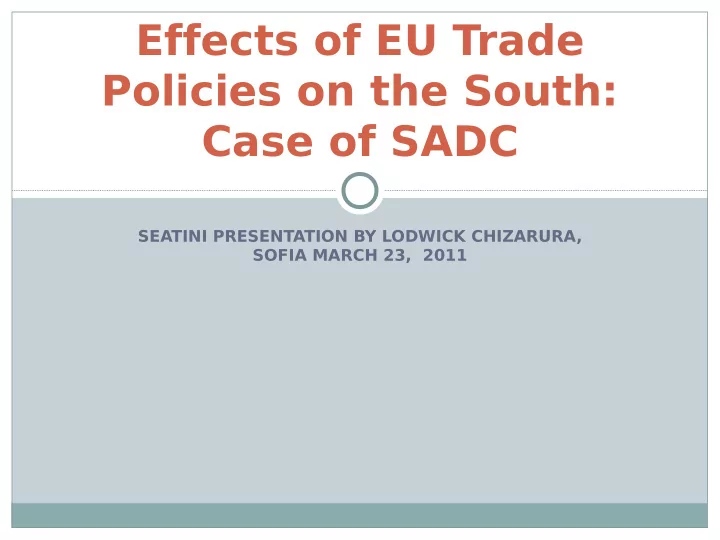

Effects of EU Trade Policies on the South: Case of SADC SEATINI PRESENTATION BY LODWICK CHIZARURA, SOFIA MARCH 23, 2011
Background Trade between ACP and EU under Lome Conventions for three decades Trade non-reciprocal Access of ACP exports into EU on preferential terms Arrangement challenged as discriminatory and preferential by Latin American countries (banana case) against WTO rules.
WTO Position Ruled in favour of the Latin American countries against the EU Enactment of a waiver to facilitate negotiations of a new agreement (Cotonou Agreement) until 2007. Negotiations begin in 2002 for new trade agreement coined EPA.
Negotiations Marked by controversies between EU and ACP countries Failure to reach agreement by 2007 Introduction of new issues into the agreement by EU that had been rejected at the WTO level. Issues concern investment, competition policy, government procurement & intellectual property rights (Singapore issues) Division of SADC into two: Malawi, Zambia & Zimbabwe (ESA) : SACU, Angola, Mozambique & T anzania (SADC)
EU-SADC Trade relations Largest trading partner Former colonies of the EU powers Though obtained political independence in the period 1960s-1990s, economic relations established during colonial era remained intact SADC (excluding S Africa) trapped in commodity dependence relying on few primary products for export earnings, making them vulnerable to volatility of world commodity prices EU considers SADC as its traditional sphere of influence, but under threat from China
State of negotiations EPA Region Countries that Countries that Countries that Countries that initialed did not Initial signed Interim initialed interim EPAs interim EPAs EPAs interim EPAs but did not (December (From June sign the EPAs 2007) 2009) ESA Comoros Djibouti Madagascar Comoros Madagascar Eritrea Mauritius Zambia Mauritius Ethiopia Seychelles Seychelles Malawi Zimbabwe Zambia Sudan Zimbabwe SADC Botswana Angola Botswana Namibia Lesotho South Africa Lesotho Mozambique Swaziland Namibia Mozambique
SADC Exports Country Commodities Angola Diamonds, oil, minerals, coffee, fish & timber Botswana Diamonds, copper, nickel Lesotho Clothing, wool, livestock Madagascar Clothing, crustaceans Malawi Unmanufactured tobacco, tea, sugar Mozambique Unwrought aluminium, , electrical energy, unmanufactured tobacco, Seafood, cotton Mauritius Clothing, sugar, fish Namibia Diamonds, copper, gold, zinc, lead, uranium, livestock, seedless grapes Seychelles Fish, beverages, tobacco Swaziland Sugar, wood pulp, minerals South Africa Platinum, coal, machinery and transport equipment, Ferro alloys Tanzania Gold, precious mineral ores, fish
Exports (continued) Refined copper, copper ores and Zambia concentrates, cobalt mattes, , tobacco Unused postage or similar stamps, Zimbabwe inedible crude materials, cut flowers, unmanufactured tobacco, cotton , agricultural products, gold, minerals
1.0Threat to Domestic Production High levels of liberalisation of at least 80% as understood by EU under the “substantial all trade clause” Botswana, Lesotho, Namibia and Swaziland (BLNS) liberalise 86% of EU imports over four years (2008-2012). Mozambique liberalize 81% of imports from the EU by 2023. Zimbabwe liberalise 80% of its imports from the EU over a period of 15 years to 2024. Angola continues trading under the Everything But Arms Initiative. South Africa trading under the TDCA
Shortfalls Failure to protect sensitive products Harmful effects on agriculture and nascent industries such as textiles Ineffective safeguard mechanisms against import surges Specialisation in the production of raw materials for export Dependency on food imports for food security
2.0 Job Losses Failure of domestic production to compete with high tech manufacturing factories in EU (textiles under SAPs) Suppression of infant downstream industries in favour of exports as a result of removal of export taxes. Destruction of livelihoods due to cheap imports for self-employed small scale farmers Migration to the West in search of menial employment (not brain drain)
Food Insecurity & neglect of agriculture Food security dependent on global primary product prices that are very volatile (net food importers-Angola, Botswana and Namibia). Standstill clauses inadequate to protect domestic production Sustained dependency on export earnings from few extractive industry and agricultural products to import food Continued neglect of agriculture due to lack of resources
Privatisation of Agriculure Introduction of contract farming Restricted to cash crop destined for export (cotton, tobacco, horticulture, sugar, tea, etc) Exclusion of food crops destined for domestic consumption (maize, tubers, small livestock) Private cos provide production support in the form of input packages. Growers deliver entire produce to contractor at prices determined by investor company Producer price too low that it drives growers into debt, become informal workers of the investor company, creating animosity between the two parties.
Liberalisation/Relaxation of Investment Regulations Extractive industries dominated by the foreign companies with technology and financial resources for the capital intensive industry. EPA to give them more rights (labour & taxes) over the domestic governments Loss of policy space by domestic governments to regulate foreign companies (joint venture, partnership, technology transfers). Mineral extraction marked by secret tax deals & relaxation of labour & environmental regulations Increased transfer of profits & dividends Destruction of domestic industries (equal treatment)
Removal of export taxes Prohibits countries from introducing new export taxes or increasing the applied taxes. Originally introduced to encourage value addition and promote downstream industries. Same path followed by developed countries historically. Effect is destruction of job creation and loss of fiscal revenue for domestic government and specialisation in unimpeded export of raw materials.
Revenue Losses Steep cuts in tariff rates result in revenue losses for government. Many governments dependent on trade revenues owing to the narrow tax base at the domestic level. WB 7-10% of governemnet revenue comes from import tariff charges. Cut in public services delivery particularly on health and education
Destruction of Regional integration initiatives Influx of EU imports inevitably competes with local regional producers thus discouraging regional integration. EU imports likely to undermine regional intra-trade especially in high-value added sectors Kenya selling 67% of manufactured products to COMESA as compared to 10% to EU, but under EU likely to lose 15% under EPA. Same fate to befall South Africa. Discouragement of South-South Cooperation under the Most Favoured Nation Clause, pre-empting competition from the emerging economies of the BRICS countries offering better deals to developing countries particularly China. 5
end THANK YOU
Recommend
More recommend